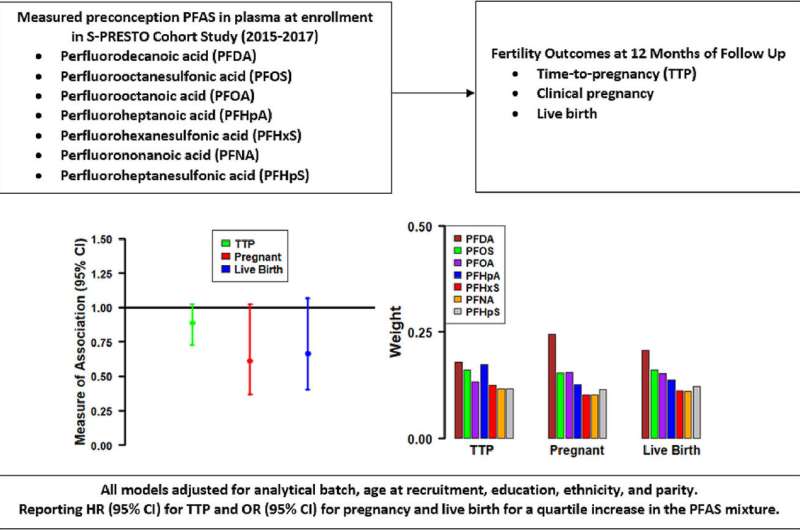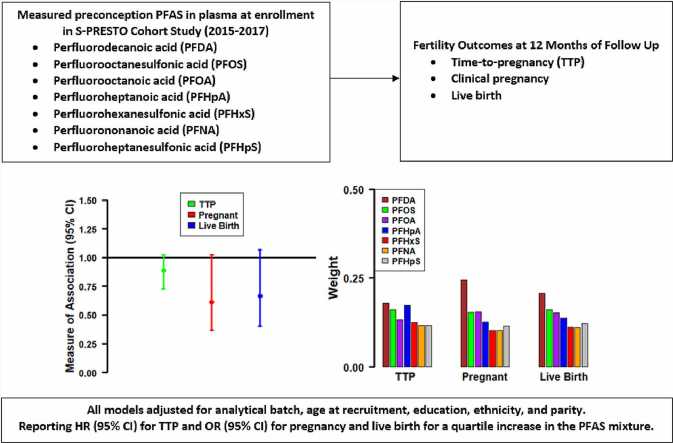
Exposure to chemicals commonly found in drinking water and everyday household products may result in reduced fertility in women of as much as 40%, according to a study by Mount Sinai researchers. In a paper published in Science of the Total Environment, the team reported that higher blood concentrations of perfluoroalkyl substances, known as PFAS, were associated with a significant reduction in the likelihood of pregnancy and live birth among a reproductive-age cohort of women in Singapore who were trying to conceive.
“Our study strongly implies that women who are planning pregnancy should be aware of the harmful effects of PFAS and take precautions to avoid exposure to this class of chemicals, especially when they are trying to conceive,” says lead author Nathan Cohen, Ph.D., a postdoctoral research fellow with the Department of Environmental Medicine and Public Health at the Icahn School of Medicine at Mount Sinai. “Our findings are important because they add to the growing body of knowledge implicating PFAS in the development of adverse health conditions, with children being especially vulnerable.”
PFAS are water- and grease-resistant chemicals found in drinking water as well as in a wide range of consumer products such as nonstick cookware, waterproof clothing, food packaging, stain-resistant coatings on carpets and upholstery, paints, and personal care products. Numerous studies have found that virtually every American has PFAS in their blood. While other studies have demonstrated that PFAS impair reproductive functioning in female mice, the Mount Sinai investigation is one of the first to show its impact in humans.
The study considered 1,032 women of child-bearing age (18 to 45 years) who were trying to conceive and who were enrolled in the Singapore Preconception Study of Long-Term Material and Child Outcomes (S-PRESTO), a population-based prospective cohort. The researchers measured PFAS in plasma collected from the women between 2015 and 2017. They learned that higher exposure to PFAS chemicals, individually and as a mixture, was associated with reduced probability for clinical pregnancy and live birth.
More specifically, the team found 30% to 40% lower odds of attaining a clinical pregnancy within one year of follow-up and delivering a live birth when the combined effects of seven PFAS as a mixture were considered. The biggest contributor to the PFAS mixture was perfluorodecanoic acid, which was individually linked to reduced fertility. Associations with infertility outcomes were also observed for perfluorooctanesulfonic acid, perfluorooctanoic acid, and perfluoroheptanoic acid.
“PFAS can disrupt our reproductive hormones and have been linked with delayed puberty onset and increased risks for endometriosis and polycystic ovary syndrome in few previous studies. What our study adds is that PFAS may also decrease fertility in women who are generally healthy and are naturally trying to conceive,” notes senior author Damaskini Valvi, MD, Ph.D., MPH, Assistant Professor of Environmental Medicine and Public Health at Icahn Mount Sinai and a nationally recognized expert on the dangers of PFAS.
“We also know that PFAS exposure begins in utero and transfers from the mother to the fetus, as many PFAS have been detected in cord blood, the placenta, and breast milk. Preventing exposure to PFAS is therefore essential to protect women’s health as well as the health of their children.”
Additional work by scientists at the Institute for Exposomic Research at Icahn Mount Sinai, which is committed to increasing the public’s understanding of how environmental exposures affect health and disease, will explore the biological mechanisms that underlie the impact of PFAS chemicals on reproductive health in women.
“The results of our study should serve as a warning to women everywhere about the potentially harmful effects of PFAS when they are planning to conceive,” says Dr. Cohen. “We can minimize PFAS exposure by avoiding foods that are associated with higher levels of these chemicals and by purchasing PFAS-free products.”
“It is also important to advocate for policies that ban the use of toxic chemicals, such as PFAS, from everyday products,” notes Dr. Valvi.
More information:
Nathan J. Cohen et al, Exposure to perfluoroalkyl substances and women’s fertility outcomes in a Singaporean population-based preconception cohort, Science of The Total Environment (2023). DOI: 10.1016/j.scitotenv.2023.162267
Journal information:
Science of the Total Environment
Source: Read Full Article
